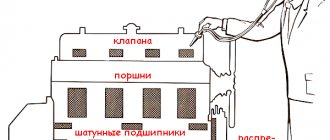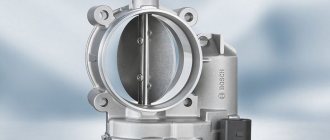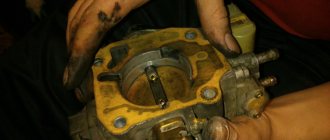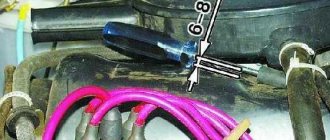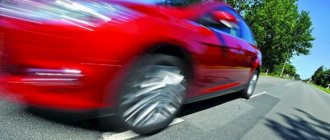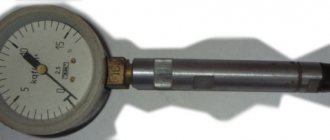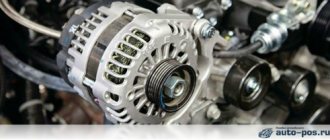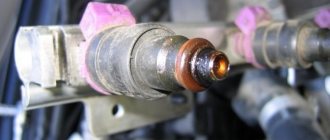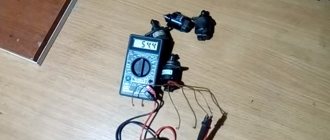Even the most reliable car breaks down. Sometimes, when pressing the gas pedal, the driver feels how his once fast car suddenly freezes and withers, and then jerks and accelerates poorly. There are several reasons for this phenomenon. Perhaps hidden damage in the power or ignition system, as well as problems with air intake, are making themselves felt. Sometimes the same effect occurs on all-wheel drive vehicles with an electromagnetic or hydraulic clutch. Some cases can be “treated” with cheap adjustments, while others can hit the owner’s pocket hard. Let's look at them in more detail.
Fuel pump
A car jerks when its engine is starved of either fuel or air, or when it doesn't have the electricity to ignite the mixture. The most common cause of jerking during acceleration is the fuel pump. After ten years of operation, due to mechanical wear, its performance decreases. It can no longer create the necessary pressure in the system and requires replacement. If the pump is faulty, jerking is sometimes accompanied by sluggishness in the car's reactions and loss of power.
Sometimes the same effect is observed due to a clogged mesh in front of the receiver neck. Also in winter, ice from condensed water may form on the mesh. Therefore, the pump has to be removed from the tank and cleaned.
Question answer
How long can you drive with the low oil light on?
What to do
If you lack knowledge or lack confidence in your own abilities, you can seek help from a service station, where specialists will conduct a diagnostic examination and repair the car.
If the user decides to figure it out on his own, he must do the following.
When I press on the gas, the car jerks and does not move.
In the case when the car behaves predictably at idle, and when the trigger is pressed, jerks are felt, and the car slowly picks up speed. The problem lies in the lean or over-enriched mixture entering the cylinders. It doesn’t matter whether it’s an old VAZ or a new modification like the Hyundai Accent. The original source is located here.
The secondary question is how this happens, because in 50% of cases the carburetor or injector is configured correctly.
The car jerks when accelerating and pressing the gas sharply
Similar symptoms occur on fuel-injected foreign cars - when the trigger is pressed firmly, the car jerks. In this case, acceleration occurs in normal mode. For cars such as Ford Focus, Opel Astra J, Chevrolet Cruze, the problem may be a breakdown of the ECU, mass air flow sensor, or TPS. The problem also does not avoid modifications of the VAZ 2114 and Audi A6 C5.
The easiest way to diagnose is to replace parts with obviously new ones. Thus, the throttle position sensor may become “stupid”, incorrectly indicating to the ECU the location of this unit, which causes variable throttle opening with all the ensuing consequences. Also, the mass air flow sensor may incorrectly interpret the indicators, which will cause the mixture to become leaner.
When you press the gas pedal, the car stalls, then jerks sharply
When a vehicle stalls during acceleration, followed by a sharp jerk, and then the dynamics stabilize. The following items need to be checked:
- air line;
- accelerator pump;
- fuel quality;
- checkpoint;
- main fuel pump;
- ignition settings;
- MRV sensor.
Owners of the Lada Priora periodically face the problem of fuel pump failure. Here it will be enough to replace the element with a new one, to be on the safe side, clean the lines (low-quality fuel could get in).
Also, in some cases, the engine begins to stall and then accelerate. Here, the mass air flow sensor is checked, the spark plugs are diagnosed, the ignition angle is checked, and the injectors are clogged.
Additionally, if you have an automatic transmission, you need to check this mechanism. About 20% of visits to a car service center with similar faults end in “treating a surprise” inside the torque converter.
The car jerks while driving when the gas pedal is pressed lightly
A more exotic malfunction is when, when you smoothly press the trigger, the car begins to twitch until the power plant reaches a certain speed. There is a lack of combustible mixture in the float chamber of the internal combustion engine - gasoline burns faster than it can flow. This is a side effect of a faulty fuel pump; the unit does not have time to pump a new portion of the mixture, which provokes engine jolts.
Note! On independent designs like the carburetor Oka or the injection Lanos, the breakdown in 90% of cases manifests itself in the same way, which narrows the search area.
The car jerks when you press and release the gas
If, when the speed is reduced, the car begins to nod, and during acceleration it jerks again, there may be two sources of the problem.
- Sensor failure. Faulty sensors send incorrect data to the ECU, causing a disruption in the uninterrupted fuel supply.
- Clogged dosing elements (nozzles, jets). Owners of classic models such as the VAZ 2107 often encounter a similar problem. A clogged injector, after releasing the gas, “spits out” part of the fuel, which causes an increase in speed. During sudden acceleration, the element does not have time to supply the required amount of mixture to the cylinder.
Carburetor car jerks when you press the gas
If a problem is detected on carburetor vehicles such as VAZ 2109/2106. First of all, you need to pay attention to the fuel supply system . The design of standard Solex carburetors has outlet tubes designed to supply gasoline to the mixture formation chamber. By pouring low-grade fuel, thin channels can become clogged, which prevents its free passage.
Usually the channel of the first chamber is clogged. If the engine jerks while gaining speed, and after reaching 2500-3000 rpm the acceleration proceeds smoothly - this is where the trouble lies. The defect is eliminated by purging the unit with compressed air and preliminary cleaning the jets (just in case).
It is also necessary to check the main pump (a problem with all classics), and the ignition timing.
When you press the gas, a car with an injection engine jerks
If the injection VAZ 2110 twitches, the search for the problem should start from the MVR, PDZ, and ECU sensors.
In this case, faulty sensors can send a false signal to the control unit, which is the primary source of the trouble. The next reason is clogged injectors. Symptoms usually appear 15-20 km after filling low-quality fuel into an empty tank.
The last point is failure, ignition interruptions. Spark plugs and armored wires are diagnosed.
Diesel car jerks when pressing gas
Regarding diesel engines, the solution to the problem is extremely simple - jamming of the moving blades of the main pump. The reason for this phenomenon is considered to be long-term downtime of transport in a damp place. It is moisture that oxidizes metal surfaces, which leads to jamming of the structure.
Failure repair is carried out by replacing the damaged part.
Clogged air filter
Air problems occur due to a clogged air filter. If it is old or not original, then its capacity may not meet the needs of the machine. If it becomes slightly clogged, its cells no longer allow enough air to pass through. And without air, gasoline does not burn or burns poorly, which is why misfires begin. Unburnt gasoline is released into the catalytic converter or into the exhaust pipe, where it burns out and produces acrid smoke. There is a loss of power.
Therefore, it is better to use filters approved for use by the manufacturer, and their service life is limited to one year.
Octane adjustment. How to properly mix AI-92 and AI-98? More details
Turbocharging faults
The lack of air in a turbocharged engine is caused mainly by a decrease in the efficiency of the turbine, which is responsible for creating pressure in the intake system. True, the effect of lack of traction only appears at high speeds during peak loads on the power unit. At low speeds the turbine is not activated.
The weak point of turbocharging is the pressure control system. The solenoid valve or electric actuator becomes sour and requires replacement. If the problem does not go away, you will have to replace the turbine assembly, which is not cheap.
Article on the topic
“Fry” until clean. Is it necessary to rev the engine to the “red zone”?
Gaps during acceleration
When accelerating a car, the load on the engine increases, which requires more fuel-air mixture, so most problems that cause failure during acceleration are associated with a lack of fuel or air. Check the condition of the fuel pump, filters, rail pressure, spark quality (in a gasoline engine). Changing the settings - mixture quality and ignition timing - is controlled by the electronics, so it is better to start diagnosing the problem by checking the dynamic indicators with a scanner directly during the trip.
Remember: if your car is equipped with an electronic “E-gas” pedal, there are usually three reasons that cause “failure” when you press it: shorted contacts, failure of the clutch and brake position sensor, or a system error.
When you press the gas pedal hard, used cars often experience a delay in the opening of the intake manifold flaps. This is a purely mechanical problem when, due to age and vigorous use, the collector becomes overgrown from the inside with a thick layer of soot “spitted out” by the cylinders of oil (and soot from the USR). The swirl flaps in the intake manifold can be cleaned or removed, just like the USR valve, but this must be done physically and programmatically, in a certified service center.
Mass air flow sensor
Incorrect data on the amount of air entering the engine leads to errors in the engine control unit, incorrect duration of opening of the injectors and, as a consequence, to the preparation of an over-enriched fuel mixture. Hence the uneven operation of the engine with dips when picking up speed. Typically, due to a faulty sensor, interruptions are not felt at idle and occur only under load.
A faulty sensor also affects the life of the exhaust system, including the catalyst, which is sensitive to exhaust cleanliness.
Common causes of engine jerking
As a rule, engine malfunctions (engine tripping, misfires, etc.) are often the reason that the power unit does not respond in a timely manner to pressing the gas pedal, after which jerking appears. This problem affects diesel and gasoline engines, injection and carburetor. Among the various elements to be checked, as well as diagnostic methods and techniques, experts highlight many items. Let's focus on the main ones.
- Oxygen sensor, which is checked with a multimeter. If a malfunction is detected, the element needs to be replaced with a new one or a known good one.
- It should also be remembered that the engine's valve timing may be disrupted. In this case, it is necessary to align the timing belt or chain as accurately as possible according to the marks.
- The stability of engine operation is also greatly influenced by the correct selection of spark plugs. To put it simply, candles differ in their heat rating. In cases where this indicator is not suitable for the engine, the spark plugs may be too cold or hot. As a result, ignition problems arise and engine misfire or engine detonation may occur.
We also recommend reading the article about why the engine does not pick up speed. From this article you will learn about the reasons why the internal combustion engine loses its responsiveness when pressing the gas pedal, the engine does not spin up, throttle response deteriorates, etc.
- As mentioned above, the cause of jerking may be injection nozzles that need to be cleaned. You can clean the nozzles and wash the injector yourself, but it is recommended to do this on a stand or wash the injector with ultrasound.
- On a car with a carburetor, jerking when you sharply press the gas appears in cases where the carburetor accelerator pump stops working correctly. In this case, the pump must be removed and its nozzle, diaphragm, channels, etc. inspected. If clogged, it must be cleaned.
Spark plugs and coils
Problems with no spark can be caused by the spark plugs. Due to burnt electrodes or large deposits in one of the spark plugs, the mixture in the combustion chambers is not ignited or does not burn completely, which is why the so-called “triple” occurs, which is accompanied by shaking at idle. Acceleration under load turns out to be “nervous”.
It is impossible to repair spark plugs. They can only be replaced.
If the problem is not in the spark plugs, the cause may be faulty coils or damage in high-voltage wires. The modular unit responsible for the ignition may also be faulty. Diagnostics will help determine the cause of the malfunction.
Not like everyone else. Why is the CVT called the most “unpleasant” transmission? More details


